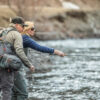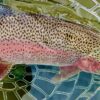“Yellowstone River closed in response to on going fish kill.” ~Montana Fish and Wildlife Website
The parasite that is killing whitefish and trout in the Yellowstone is present in many rivers in the West and under normal conditions healthy fish are resistant. The extremely low flows on the Yellowstone River and warm temperatures has weakened fish immune systems making them prone to parasites. Several years ago, The Nature Conservancy set up wader and boot washing stations at all access points on the Preserve to help prevent the spread of the New Zealand Mud Snail. With the recent events in Montana, we are reminded again of the importance of cleaning all of our equipment to help thwart the spread of invasive species. As anglers, we need to do all we can to protect the environs we love so much. That said, please take the time to clean your waders, boots, and float tubes before fishing our waters. Thanks!
SILVER CREEK
This is a great time to fish the Creek, as most of the heavy summer traffic has dissipated. While there is still some late morning action with a few Tricos remaining, along with some Baetis, the real action has shifted to the Callibaetis in the afternoon. This bug is smaller than the early season Callibaetis, so you will need to have plenty of size 18 and 20s in all phases of this insects life cycle (nymphs, emergers, duns and spinners). To find the Callibaetis, search the sloughs and slow water stretches of the upper and lower Kilpatrick’s Pond. The fly is easily identified by its rhythmic bouncing just above the water as it prepares to lay its eggs. On windy days, try a size 16 or 18 Hackle Stackers along with a Quigley Cripple or the Callibaetis Floating Nymph. When the water is still, try Harrop’s Partridge Spinner or Harrop’s Cutwing Dun in a size 18. Also watch the weather forecast over the next few weeks as cloudy, cool days will trigger fantastic Baetis hatches. These Baetis are small and you will need patterns in size 20, 22, and 24 to match the hatch. For this bug, size is more important than color and fish should take any well presented fly. Also, be prepared for some Mahogany Duns as they will make an appearance in the coming weeks. It is worth repeating that while fishing the Creek this season has been spectacular at times, the fishing in general remains spotty due to low water and erratic hatches. Much of the walk and wade portions of the Preserve are simply too shallow forcing most of the fish to seek the protection of deeper, cooler water.
BIG WOOD
September on the Wood can be fantastic. Keep in mind, for the best results you want to seek out water that has not received a ton of fishing pressure. This is getting easier now that school is back in session. Also, with the low water it is important that you approach the water carefully and scan the water for feeders in the shallows. Often the largest fish hold in the least likely water and these fish can be spooky. For dries, I recommend using small Gulper Specials (18) with orange posts which show up nicely in the glare and light chop of riffles. Also, a few Red Quills have been spotted in the South Valley and should make their way up river as we head into cooler temperatures in the weeks to come. Terrestrials have also been a good bet, especially hoppers and flying ants. Trailing a small size 16 or 18 Zebra Midge in red or black, a pheasant tail, Bishop’s Dynamite, or Rainbow Warrior can also be effective during slow periods. Also, Euro Nymphing is a great way to turn those missed takes into hookups. For a change of pace, try Euro Nymphing with a Japanese Tenkara Rod!
THE SALMON
With the low and crystal clear water, the dry fly action on both the upper and lower river in the afternoons is improving. Nymphing and streamer fishing is your best option if your are looking for continual action. For dries try an assortment of attractors in size 12 through 16 from Royal Wulff’s, to Parachute Adams and Orange Stimulators. Also, size 12 tan or olive Elk Hair Caddis work well to imitate the Spruce Moths along the banks of wooded water. For nymphs, try Rubber Legged Stones, Bishop’s Dynamite, or King Princes. Standard black or brown buggers work well.
THE UPPER LOST
With the cooler temps the fishing is best during the middle of the day. The main stem continues to produce some fantastic fish, but you need to work for them. If you cover lots of water you will find good holding water for rainbow, cutbow, cutthroat and mountain whitefish. Keep in mind, the trout will give you one chance, so make your first presentation count. Otherwise, be prepared to walk a long ways to the next fishy spot. For searching, try a Para Hopper, a flying ant, or an Elk Hair Caddis in size 14, 12 or 10 with a small trailing Zebra Midge, Bishop’s Dynamite, or Rainbow Warrior. If you find some feeders, use small size 18 parachute patterns, a long leader, and fine tippet.
BIG LOST – MACKAY
The flows continue to drop. They are currently at 290 CFS and could continue to come down as demands for irrigation diminish. Expect the Trico and Baetis hatches to remain strong. The lower flows could get the mid morning into early afternoon dry fly action going! Take a good number of House of Harrop Baetis and Tricos in size 20 to 24 and with the cooler temps expect the hatch and spinner fall to move to the middle of the day. Nymphing is always effective and with lower flows, sight nymphing with a single small Pheasant Tail, Zebra midge, or small Baetis nymph can be fun and effective. Standard dry dropper rigs or Euro Style techniques with a Rainbow Warrior, Iron Lotus, or Bishop’s Dynamite are very effective. You might also try a dancing large crane fly pattern; we have a great selection of Mackay Specials.
SOUTH FORK OF THE BOISE
It is that time of year when the flows drop dramatically on the South Fork. With the lower flows (600 CFS), the river is completely accessible to wade anglers. Hoppers have been turning fish, but the main action is in the afternoon on Pink Alberts. You will need to scan the water carefully looking for this bug and any fish feeding on it. Be sure to have both dun and emerger patterns to fool these picky fish. Nymphing can fill in the periods before and after the Pink hatch; try large rubber leg stone flies, caddis, and midge patterns.
LOCAL PONDS
Lake Creek, Penny Lake, or Gaver’s Lagoon have been stocked and will receive regular stockings throughout the summer season. These are great places for a family picnic or a fly fishing lesson. Whatever style of fishing you want to do, we are your headquarters, so drop on by and we will make sure you have the right gear to be successful.
|
Silver Creek Big Wood South Fork of the Boise The Salmon The Big Lost Copper Basin |
54 cfs 126 cfs 611 cfs 369 cfs 308 cfs 30 cfs |




